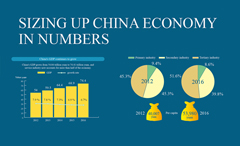China’s economy: Good news from China for the world
2017-10-10
cgtn.com
How has the Chinese economy been faring in the last five years? Head of China’s National Statistics Bureau Ning Jizhe gave the answer in a news conference on October 10 in Beijing.
According to Ning, China’s economic growth averaged within a proper range at 7.2 percent between 2013 and 2016. In the first half of this year, China’s GDP stood at 6.9 percent, with Ning saying the Chinese economy is moving forward at a steady pace.
That’s good news for China and for the whole world as well. Many economists are predicting that the world economy is seeing a wide recovery, despite still undergoing restructuring and transformation. Some forecast that US economic growth will reach 2.3 percent in 2017 after a growth rate of only 1.6 percent last year, the lowest since 2011.
There is enough reason to be cautiously optimistic, at least, for the prospects of the world economy this year and perhaps in the next couple of years as well.
I have to say it is especially true now that China’s economy is still stable and robust. According to the International Monetary Fund, China’s contribution to the world economy far surpassed that of the US and Europe combined. In fact, figures show that China’s contribution to the world’s economic growth has stood at 30 percent in the last few years. Therefore it is of greater significance that China’s economy remains steady and growing.
As for those who have predicted again and again that China’s economy is going to break down, they are proved wrong again. I have to say that they don’t really understand the Chinese economy, its resilience and self-sustainability. Not like many other economies which rely on only one or few pillars, the Chinese economy is driven by many pillars. Normally, investment, exports and domestic demand are believed to be the three main pillars of the Chinese economy. Others believe there are four pillars for the Chinese economy, namely foreign direct investment, the industrial sector, government spending and national consumption.
Now, there are even more pillars — the so-called new economy, such as mobile technology, e-commerce, new energy and high-tech industry. China is pushing forward with an innovation-driven economy, seeking new growth areas. Urbanization is also a new driving force for economic growth.
So, China does not put all of its eggs in one basket. For example, China boasts a complete industrial system. It won’t be a life or death issue once one or two sectors of the industry suffer from stagnant development. Moreover, China itself is a huge market with one of the world’s largest economies. It can provide that self-sustainability in terms of both supply and demand.
Of course, China’s economy has its problems, some of which are very serious. These problems include growth imbalance regionally and sector wise, regional debt and skyrocketing housing prices. China is actively dealing with these problems, including restructuring the economy. I have to say that the “China collapse theory” is not necessarily a bad thing. It is a constant warning bell calling for China to always be cautious about the dangers and traps in its development path.
I would advise the Chinese government not to worry too much about the so-called “China collapse theory” but to take it as a healthy alarm.
I also believe that leaders with vision can foresee the problems and fix them before they get out of hand. And they will not only fix current problems, they will also invest in the future.



